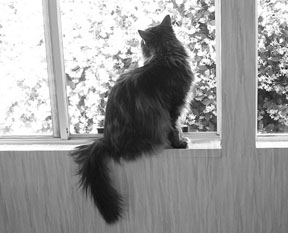If there are 100 good reasons for a smoker to kick the cigarette habit, there are 101 good reasons if he or she happens to live with an asthmatic cat. Cigarette smoke is just one of the countless allergy-producing substances (allergens) that can trigger the onset of the labored breathing, wheezing, coughing, and other signs that characterize feline asthma.
Other common asthma-causing allergens include dusty kitty litter; vapors from household cleaning solutions and aerosol sprays; pollen from trees, weeds, and grass; mold and mildew; dust mites; smoke from fireplaces and candles; and even some foods, although food allergies most frequently manifest themselves in skin or gastrointestinal problems.
A Mechanical Problem
According to Richard Goldstein, DVM, service chief of internal medical at Cornell University Hopsital for Animals, asthma is the most common of all feline respiratory disorders. He describes the condition as a mechanical constriction of the airways, or bronchi (the branching system of tubes that lead from the trachea through the lungs). The narrowing of the airways occurs when a cats immune system overreacts to the presence of an allergen and responds by releasing stimulants that cause a swelling of the tissue (mucous membrane) lining the bronchi. In some cases, the tissue may also become inflamed. However, Dr. Goldstein points out that inflammation is not always present in asthma. This distinguishes it from bronchitis, in which airway inflammation always occurs.
In many respects, feline asthma is a mysterious disease. Young and old cats seem to be similarly predisposed to it. Likewise, males and females appear equally at risk.
Genetics may possibly play a role, says Dr. Goldstein, and veterinary scientists throughout the U.S. are striving to identify the heritable factors that may make one cat – or one breed – more vulnerable to asthma than another. But at present, the role of genetics remains unclear. Some people think, for example, that the condition may be more common in Siamese cats, he notes, but this has not been shown in large studies. Meanwhile, says Dr. Goldstein, it is safe to say that outdoor cats are more likely than indoor cats to be asthmatic simply because they are routinely exposed to many more potential allergens.
Danger Signs to Look For
Frequent bouts of audible wheezing and recurrent retching – as if the cat is attempting to cough up a hairball – are among the clear signs of bronchial stress stemming from chronic asthma. The earliest sign of an acute and perhaps life-threatening attack, however, is labored breathing (dyspnea), which may or may not be accompanied by wheezing or coughing.
According to Dr. Goldstein: The cat is at rest, not doing anything at all. Or else shes playing and suddenly stops. She begins breathing rapidly, and soon begins trying to take in air with her mouth open. Her chest and abdomen move up and down abnormally, the breathing is shallow and rapid. And if you listen closely you may be able to detect a wheezing sound on expiration – as she exhales air from her lungs. If you notice this, you should get veterinary help right away.
If the dyspnea progresses, the cats normally pink ears, lips, nose, and gums may turn blue from lack of oxygen, in which case emergency veterinary care is mandatory. The attentive cat owner can most likely avoid the perilous eventuality of an acute attack by recognizing the signs of chronic asthma and seeking veterinary counsel before the disorder gets out of hand.

288
The Diagnostic Path
Precisely pinpointing asthma as the cause of a cats chronic respiratory discomfort is challenging, says Dr. Goldstein, since many other conditions may be responsible for such signs as recurrent wheezing, coughing, and dyspnea. For this reason, the standard diagnostic approach, he says, is exclusionary – it attempts to rule out these other conditions. Accordingly, the first diagnostic step is a thorough physical exam, during which the veterinarian will attempt to locate the source of any wheezing. This is possible with the use of a stethoscope, which can detect a subtle sound emanating from deep within a cats body that is not otherwise audible. In the exam, the veterinarian will also attempt to rule out heart and lung problems that may cause asthma-like respiratory difficulty.
Next, says Dr. Goldstein, the cats blood will be tested to see, among other things, whether there is a suspicious over-representation of white blood cells called eosinophils, which may be associated with the allergic response. But usually, he observes, the bloodwork is pretty normal.
The third step on the diagnostic path is likely to involve X-rays. A cat may seem perfectly normal, but x-rays can show overinflation of the lungs that results from their effort to open up the narrowed bronchi to allow the passage of expired air, says Dr. Goldstein.
Finally, the veterinarian may order a fecal exam to rule out the presence of lungworm, a parasite that can live in the feline bronchi and cause asthmatic signs. Early stages of this parasite can be found in an affected animals feces. A test for heartworm is also useful in diagnosing asthma, as some of the signs are similar.
Based on these measures, says Dr. Goldstein, the veterinarian may be able to make a presumptive diagnosis of asthma. The cost of the diagnosis is likely to be in the $200 to $400 range, he says. The full diagnostic procedure is worthwhile, he adds, since an inaccurate diagnosis may result in a cats being put on inappropriate medicines that may lead to side effects and, as a result, a lot of additional veterinary costs down the line.
Treatment Approaches
Like human asthma, chronic feline asthma is incurable but generally manageable. According to Dr. Goldstein, treatment depends on the severity of the condition, and most commonly involves the use of a corticosteroid drug to reduce bronchial inflammation in combination with a bronchodilator to open up the airways. In most cases, these drugs can be used at home, they are effective both therapeutically and preventively, and they may be administered in a variety of ways – orally in tablet form, through injection, or via a dermal gel that is applied directly to the ailing cats skin.
In recent years, Dr. Goldstein and other veterinary experts have come to favor administering corticosteroid drugs such as fluticasone proprionate (Flovent) and bronchodilators such as albuterol (Proventil, Ventolin) as inhalants, either daily or as needed. The drugs are contained in little chambers called spacers, explains Dr. Goldstein, which fit into a mask that is placed over an asthmatic cats face for 10 seconds or so. Thats long enough, he says, for the cat to take a few breaths and inhale a puff or two of the drug. The advantage of the inhaler is that a higher level of the drug gets to the lungs. He and his colleagues expect to see an increased use of inhalant therapy in the future.
Preventive Measures
In many cases, cat owners can avoid the discomforting, distressful, and potentially life-threatening signs of feline asthma by identifying allergens and removing them from their homes. And we dont do a very good job of that, Dr. Goldstein notes.
Although commercial labs have developed methods for identifying substances that cause allergic reactions affecting the feline skin and gastrointestinal system, he points out that no sure methods have as yet been found regarding respiratory system allergens.
The more we prevent our cats from coming in contact with dust mites, irritating cat litter, smoke, and other bronchial irritants, Dr. Goldstein says, the fewer cats will need asthma treatment. He is hopeful that most cat owners would eagerly adopt a trial-and-error approach to identifying such dangerous allergens and would then take the necessary steps to asthma-proof their homes. Ive known people, he says, who wouldnt give up smoking for their own sake or for that of their children but who finally managed to do it for their cats.


